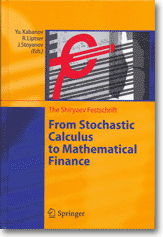The Shiryaev Festschrift: "From Stochastic Calculus to Mathematical Finance": Preface

Preface
This volume contains a collection of articles dedicated to Albert Shiryaev on his 70th birthday. The majority of contributions are written by his former students, co-authors, colleagues and admirers strongly influenced by Albert's scientific tastes as well as by his charisma. We believe that the papers of this Festschrift reflect modern trends in stochastic calculus and mathematical finance and open new perspectives of further development in these fascinating fields which attract new and new researchers. Almost all papers of the volume were presented by the authors at The Second Bachelier Colloquium on Stochastic Calculus and Probability, Metabief, France, January 9-15, 2005.
Ten contributions deal with stochastic control and its applications to economics, finance, and information theory.
The paper by V. Arkin and A. Slastnikov considers a model of optimal choice of an instant to launch an investment in the setting that permits the inclusion of various taxation schemes; a closed form solution is obtained. M.H.A. Davis addresses the problem of hedging in a "slightly" incomplete financial market using a utility maximization approach. In the case of the exponential utility, the optimal hedging strategy is computed in a rather explicit form and used further for a perturbation analysis in the case where the option underlying and traded assets are highly correlated.
The paper by G. Di Masi and L. Stettner is devoted to a comparison of infinite horizon portfolio optimization problems with different criteria, namely, with the risk-neutral cost functional and the risk-sensitive cost functional dependent on a sensitivity parameter γ < 0. The authors consider a model where the price processes are conditional geometric Brownian motions, and the conditioning is due to economic factors. They investigate the asymptotics of the optimal solutions when γ tends to zero. An optimization problem for a one-dimensional diffusion with long-term average criterion is considered by A. Jack and M. Zervos; the specific feature is a combination of absolute continuous control of the drift and an impulsive way of repositioning the system state.
Yu. Kabanov and M. Kijima investigate a model of corporation which combines investments in the development of its own production potential with investments in financial markets. In this paper the authors assume that the investments to expand production have a (bounded) intensity. In contrast to this approach, H. Pham considers a model with stochastic production capacity where accumulated investments form an increasing process which may have jumps. Using techniques of viscosity solutions for HJB equations, he provides an explicit expression for the value function.
P. Katyshev proves an existence result for the optimal coding and decoding of a Gaussian message transmitted through a Gaussian information channel with feedback; the scheme considered is more general than those available in the literature.
I. Sonin and E. Presman describe an optimal behavior of a female decision-maker performing trials along randomly evolving graphs. Her goal is to select the best order of trials and the exit strategy. It happens that there is a kind of Gittins index to be maximized at each step to obtain the optimal solution.
M. Rásonyi and L. Stettner consider a classical discrete-time model of arbitrage-free financial market where an investor maximizes the expected utility of the terminal value of a portfolio starting from some initial wealth. The main theorem says that if the value function is finite, then the optimal strategy always exists.
The paper by I. Sonin deals with an elimination algorithm suggested earlier by the author to solve recursively optimal stopping problems for Markov chains in a denumerable phase space. He shows that this algorithm and the idea behind it can be applied to solve discrete versions of the Poisson and Bellman equations.
In the contribution by five authors — O. Barndorff-Nielsen, S. Graversen, J. Jacod, M. Podolski, and N. Sheppard — a concept of bipower variation process is introduced as a limit of a suitably chosen discrete-time version. The main result is that the difference between the approximation and the limit, appropriately normalizing, satisfies a functional central limit theorem.
J. Carcovs and J. Stoyanov consider a two-scale system described by ordinary differential equations with randomly modulated coefficients and address questions on its asymptotic stability properties. They develop an approach based on a linear approximation of the original system via the averaging principle.
A note of A. Cherny summarizes relationships with various properties of martingale convergence frequently discussed at the A.N. Shiryaev seminar. In another paper, co-authored with M. Urusov, A. Cherny, using a concept of separating times makes a revision of the theory of absolute continuity and singularity of measures on filtered space (constructed, to a large extent by A.N. Shiryaev, J. Jacod and their collaborators). The main contribution consists in a detailed analysis of the case of one-dimensional distributions.
B. Delyon, A. Juditsky, and R. Liptser establish a moderate deviation principle for a process which is a transformation of a homogeneous ergodic Markov chain by a Lipshitz continuous function. The main tools in their approach are the Poisson equation and stochastic exponential.
A. Guschin and D. Zhdanov prove a minimax theorem in a statistical game of statistician versus nature with the f-divergence as the loss functional. The result generalizes a result of Haussler who considered as the loss functional the Kullback-Leibler divergence.
Yu. Kabanov, Yu. Mishura, and L. Sakhno look for an analog of Harrison-Pliska and Dalang-Morton-Willinger no-arbitrage criteria for random fields in the model of Cairolli-Walsh. They investigate the problem for various extensions of martingale property for the case of two-parameter processes.
Several studies are devoted to processes with jumps, which theory seems to be interested from the point of view of financial applications.
To this class belong the contributions by J. Fajardo and E. Mordecki (pricing of contingent claims depending on a two-dimensional Lévy process) and by D. Gasbarra, E. Valkeila, and L. Vostrikova where an enlargement of filtration (important, for instance, to model an insider trading) is considered in a general framework including the enlargement of filtration spanned by a Lévy process.
The paper by H.-J. Engelbert, V. Kurenok, and A. Zalinescu treats the existence and uniqueness for the solution of the Skorohod reflection problem for a one-dimensional stochastic equation with zero drift and a measurable coefficient in the noise term. The problem looks exactly like the one considered previously by W. Schmidt. The essential difference is that instead of the Brownian motion, the driving noise is now any symmetric stable process of index a α![]() ]0,2].
]0,2].
C. Klüppelberg, A. Lindner, and R. Mailer address the problem of modelling of stochastic volatility using an approach which is a natural continuous-time extension of the GARCH process. They compare the properties of their model with the model (suggested earlier by Barndorff-Nielsen and Sheppard) where the squared volatility is a Levy driven Ornstein-Uhlenbeck process.
A survey on a variety of affine stochastic volatility models is given in a didactic note by I. Kallsen.
The note by R. Liptser and A. Novikov specifies the tail behavior of distribution of quadratic characteristics (and also other functionals) of local martingales, with bounded jumps extending results known previously only for continuous uniformly integrable martingales.
In their extensive study, S. Lototsky and B. Rozovskii present a newly developed approach to stochastic differential equations. Their method is based on the Cameron-Martin version of the Wiener chaos expansion and provides a unified framework for the study of ordinary and partial differential equations driven by finite- or infinite-dimensional noise. Existence, uniqueness, regularity, and probabilistic representation of generalized solutions are established for a large class of equations. Applications to non-linear filtering of diffusion processes and to the stochastic Navier-Stokes equation are also discussed.
The short contribution by M. Mania and R. Tevzadze is motivated by financial applications, namely, by the problem of how to characterize variance-optimal martingale measures. To this aim the authors introduce an exponential backward stochastic equation and prove the existence and uniqueness of its solution in the class of BMO-martingales.
The paper by J. Oblój and M. Yor gives, among other results, a complete characterization of the "harmonic" functions H(x,![]() ) for two-dimensional processes (N,
) for two-dimensional processes (N, ![]() ) where N is a continuous local martingale and
) where N is a continuous local martingale and ![]() is its running maximum, i.e.
is its running maximum, i.e. ![]() t := sups
t := sups![]() t Nt. Resulting (local) martingales are used to find the solution to the Skorohod embedding problem. Moreover, the paper contains a new interesting proof of the classical Doob inequalities.
t Nt. Resulting (local) martingales are used to find the solution to the Skorohod embedding problem. Moreover, the paper contains a new interesting proof of the classical Doob inequalities.
G. Peskir studies the Kolmogorov forward PDE corresponding to the solution of non-homogeneous linear stochastic equation (called by the author the Shiryaev process) and derives an integral representation for its fundamental solution. Note that this equation appeared first in 1961 in a paper by Shiryaev in connection with the quickest detection problem. In statistical literature one can meet also the "Shiryaev-Roberts procedure" (though Roberts worked only with a discrete-time scheme).
The note by A. Veretennikov contains inequalities for mixing coefficients for a class of one-dimensional diffusions implying, as a corollary, that processes of such type may have long-term dependence and heavy-tail distributions.
Robert Liptser
Jordan Stoyanov











